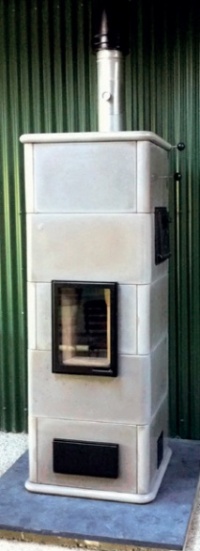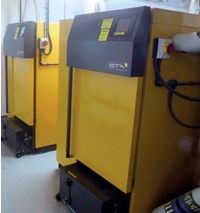Heating National Trust Properties
Emma Griffiths
 |
|
| Blickling Hall, Norfolk, where the National Trust recently installed a 200kW lake source heat pump |
As the UK's largest private landowner and custodian of many of Britain’s most treasured historic buildings, the National Trust (NT) has a varied range of properties in its care. These include 300 major historic houses, office buildings, visitor centres, 360 holiday cottages and around 5,000 tenanted farmhouses and cottages on NT estates.
Climate change now poses the single biggest threat to the places the trust looks after bringing new, damaging threats to a natural environment already under pressure. It also poses a growing conservation challenge for the houses and gardens in the NT’s care, not least as a result of the increasing frequency of extreme weather events.
The trust currently spends nearly £6 million a year on electricity, oil and gas, offering a clear business incentive to use energy more efficiently and, where possible, to produce its own. Aside from the economic benefits of moving towards a renewable future, playing its part in mitigating climate change is an organisational priority for the trust as a conservation charity. The National Trust aims to cut energy usage by 20 per cent from 2008 levels by 2020 and to generate 50 per cent of that from renewable sources on its own land.
In the summer of 2015 the trust made its biggest ever investment in renewable energy to heat and power more of the historic places it looks after. The Renewable Energy Investment (REI) programme followed the successful completion of five renewable energy projects at NT properties, part of a £3.5 million pilot launched in 2013.
In one example, a 5,000-litre oil tank in the grounds of Ickworth, Suffolk was removed following the installation of a biomass boiler, removing the risk of contamination from oil leaks. Using wood fuel sourced directly from the estate created an even bigger conservation dividend. As well as the mansion becoming self-sufficient in heat, the new woodland being planted to secure future fuel helped reinstate lost design features from the Grade II listed park and gardens. The more actively managed woodlands are also helping to create larger, better habitats and improve nature conservation.
Following the success of these schemes and the experience gained, the ten-year REI programme was launched with the expectation that it would enable the trust save up to £4 million on its energy costs each year. Electricity generated from some of the projects will be sold to the grid providing a new source of income.
The trust is investing in more than 40 further projects which include:
- a 200kW lake source heating project on the Blickling Estate in Norfolk, which will remove two oil tanks and 25,572 litres a year of oil consumption with an estimated saving of 68 tonnes of CO2 per year
- two biomass boilers at Upton House in Warwickshire to heat the mansion and other areas, saving an estimated 55 tonnes of CO2 per year
- a 250kW hydro scheme at Hayeswater in Cumbria where there is a legacy of hydropower from historic corn mills and water wheels – this project will provide an income stream to support conservation work on land the trust cares for.
As well as generating and using renewable energy, the trust has set about implementing high energy efficiency standards in all buildings and operations. This is being achieved by increasing standards of insulation and draught proofing, using water-saving devices and smart meters, fitting double or secondary glazing, using thermostatic heating controls, and installing energy-efficient equipment and lighting.
Many of the properties in the trust’s care are energy intensive and in remote areas without access to mains gas. So far, the trust has fitted over 60 of its properties with renewable heating systems tailored to the needs of each property. Ultimately, the overriding goal is to switch to sustainable forms of energy to reduce reliance on fossil fuels.
HEAT PUMPS
The REI Programme has achieved results by fitting both biomass appliances and heat pumps, depending on which technology suits the individual site. At Plas Newydd, on the Menai Strait in North Wales, a 300kW marine source heat pump fitted the conservation heating needs of the property. And at Blickling Hall in Norfolk, the trust has nearly finished installing a 200kW lake source heat pump to heat the main hall.
At more isolated, rural properties such as Blickling, getting the right electrical load on site can prove challenging. Prior to installation of the heat pump, the system was already operating at the capacity of its electrical load so a system upgrade was required. This can be challenging, particularly if the electricity distribution network operator (DNO) needs to upgrade the invertors, cabling and/or transformers required to power the heat pump. The DNO often has its own operational constraints and challenges. It is also expensive because the technology and materials are complex and use a significant amount of copper, and the costs incurred by the DNO must be met by the developer.
When considering whether a lake is suitable for a water source heat pump, distance from the property is important both in terms of cost for civil engineering and pipework, and for heat losses in pumping a longer distance. The relative elevation of the property and the water will be relevant too because more energy is required to pump uphill.
The volume of water in the lake, its depth and the flow rate of water refreshing it impact on how much heat can be generated without significantly altering the overall temperature. How much energy the heat pump needs to take out will depend on the size and heating requirements of the building it is being used to heat. Crucially, the sensitivity of the ecology in the lake or river to temperature change and to disturbance caused by the installation of collectors has to be taken into consideration.
The trust has to select lake sites for extracting heat carefully to ensure that the area, depth and flow rate can be maintained over the course of the year. Many trust lakes are spring-fed, ensuring that the ‘fuel source’ is replenished constantly.
Independent studies by SEACAMS, a marine science research scheme, have shown that disruption to biodiversity can also occur during construction. Mitigation measures need to be carefully considered and incorporated in a method statement agreed with the Environment Agency and other statutory bodies as necessary (such as planning and heritage authorities where archaeological sites are involved). It is important to keep these bodies fully engaged during the design stage of the project.
Sometimes the trust also faces challenges around the sensitive archaeological nature of its sites. It is often necessary to seek specialist guidance and take precautions to avoid affecting significant archaeological finds, which can include whole Saxon villages. This can make it problematic to excavate large areas of a site to develop schemes such as ground source heat pumps.
Choosing the most appropriate type of energy for some National Trust properties can be a difficult challenge. For example, the trust’s historic art and house collections at Beningborough Hall in North Yorkshire require lower heat levels and would only need a 90kW biomass boiler, but this option may not be financially viable, especially following substantial reductions in payments made under the Renewable Heat Incentive in 2015/16 for biomass heating installations of less than 200kW. On the other hand, a heat pump might not provide the right solution either, because the heat emitters are too small. Ground-source heat pumps work most efficiently with underfloor heating systems due to the lower temperature requirements of a large emitter, but installation is rarely possible due to both conservation issues and financial constraints.
WOOD FUEL
 |
|
| Wood-fired storage heater or ‘masonry stove’ at Llanerchaeron, Ceredigion |
Log heating systems such as stoves and boilers are ideal for houses but in larger properties they require more frequent refilling so in these environments other types of wood fuel such as wood chips and pellets are mostly used in automated systems.
Wood chips can be made from virtually any kind of woody biomass, including whole trees, by a chipping machine. This makes it possible for the trust to supply fuel from its own estates. Wood chips are typically used in automated systems making them a clean and convenient heating option for the trust.
Pellets are relatively new in the UK but they have been used in central Europe for some time. They are produced from wood by-products such as sawdust and have a better calorific value which means the energy to weight ratio is very favourable, so they are more appropriate for smaller spaces.
The visitor building at Penrhyn Castle in Wales has a new wood pellet space heater with a hot-air convector built in, which heats the whole building.
In simple carbon dioxide emission terms the log stove at another trust property, Llanerchaeron tea room, emits considerably less carbon dioxide per kWh than the new high-tech pellet stove at Penrhyn. Research has shown that log stoves emit around 4g of carbon dioxide per kWh compared to 34g per kWh for a wood pellet system (and around 500g per kWh for an electric heater using power from the grid).
Deciding whether a pellet stove or a log stove is more suitable for a particular site can come down to the ability to manage the stoves. Cutting, hauling, drying and splitting logs, or just supplying them, as well as loading and cleaning the stove are all time-consuming and members of staff have other tasks to carry out. It can come down to the simple question: ‘Do you have the space to store the fuel and the time to manage the fire?’
Expense can also be a consideration. The Tigchelaar wood-fired storage heater or ‘masonry stove’ at Llanerchaeron is over 90 per cent efficient and a very good space heater but it is also twice the price of some stoves. On the other hand, there is a simple Clearview stove space heater in Colby Woodland Garden which is significantly cheaper than the masonry stove, and far cheaper than any pellet system.
Fuel is important and the trust ensures that its wood fuels are produced in the UK from FSC timber and from as local a supplier as possible, if not from its own estates. Wood chip and pellets must also conform to the relevant standards (including DIN 66 165).
In some cases, using the natural resources that properties and estates have access to creates additional conservation wins. The biomass system at Croft Castle in Herefordshire uses wood from conifer trees on the estate to heat the property. Removing the conifers has exposed ancient wood pasture and led to an increase in biodiversity.
CASE STUDY 1:
A wood pellet range cooker in a farmhouse in Snowdonia
At Hafod y Llan in Snowdonia, the trust experimented with a Klover 120 wood pellet range cooker. The requirement was for a viable, economic, manageable biomass cooker and central heating appliance which could simply replace the host of oil-fired range cookers (Aga, Stanley, Rayburn, Esse, etc) used in many similar farmhouses and cottages.
The building is a fairly typical three-bedroom farm-house with moderate levels of insulation, draught-proofing and retrofitted windows. The appliance had no problem at all heating it. When used all day, two 20kg bags of pellets were consumed and this fell to one bag a day if the property was heated only in the morning and evening. In the summer months just half a bag a day was used for hot water. A fossil-fuel boiler was retained as a backup, but it has never been needed.
In winter-heating mode the fuel was burning much more cleanly and only leaving a very fine ash. In summer there was some partially burnt pellet but this was not an issue. The daily and weekly controls were not very intuitive at first but are adequate once members of staff get used to them.
As a cooker it performed well overall, if a little less refined than an Aga. The oven could be a tad hot (200°C+ top and 180°C bottom of the oven), and it was a matter of trial and error at the start. Using the hob plate also took some practice, with a range of temperatures across the surface.
A simple slot-in electric plate cooker was also provided for minor cooking requirements (boiling an egg for example), to avoid having to crank up the oven unnecessarily.
Overall the trial was a success. An estimated saving of about £400 per annum was achieved with the Klover, and the house is also much warmer. The conclusion is that this is a suitable option for replacing oil range cookers.
CASE STUDY 2:
Wood pellet boilers at Upton House
Towards the end of 2015 the first completed Renewable Energy Investment Programme project, Upton House, Warwickshire made the switch from oil to a renewable energy heating system.
 |
||
| Upton House, Warwickshire was using 25,000 litres of oil each year before the installation of two wood pellet boilers, which are now saving £6,000 a year on energy bills and 55 tonnes of CO₂ emissions. |
Former Shell chairman Lord Bearsted gifted the estate and its extensive art and porcelain collections to the National Trust in 1948. It was using 25,000 litres of oil each year to heat the various buildings (which equate to around 11 average houses). Today, the heating is powered by two new wood pellet boilers, saving £6,000 a year on energy bills and 55 tonnes of CO2 emissions.
Four oil boilers were removed and the new biomass system now heats the house, site offices, squash court gallery, restaurant and a cottage.
According to Ed Wood, the renewables project manager at Upton: ‘The irony that the estate was owned by a family whose fortune was built on oil was not lost on us when we started our project to take Upton off fossil fuel. In the past, oil was the most effective way to heat the estate. Times have changed and to lower our carbon emissions and meet our target, to generate 50 per cent of all energy we use from renewable sources by 2020, we felt it was important to change our energy source here.’
This is a great example of what support from the Renewable Heat Incentive scheme is enabling the trust to do.
Schemes like these cut carbon emissions, promote local sustainable wood management and work in harmony with the natural and built environment. They work for the local environment and economy and support national energy and climate change reduction initiatives.
FUNDING
Recent changes to government incentives (the Renewable Heat Incentive and the Feed in Tariff or ‘FIT’ scheme) have seen a shift in support for certain renewable energy technologies and system sizes.
The FIT rates for smaller hydroelectric installations are lower than the trust had hoped. However, the government has reinstated pre-accreditation, reducing the risk of the longer lead-in times associated with hydro projects. The trust has been working hard not only on financial modelling of its hydro potential but also revisiting its approach to construction methodologies and procurement approaches before making any final decisions.
The RHI consultation led to the introduction of an annual budget cap based on deployment of technologies which means that once a certain threshold is reached the RHI is no longer available for that technology/size. However, the good news is that a tariff guarantee will be introduced for heat pumps over 100kW and for large scale biomass. In addition, tariffs for heat pumps are predicted to rise as the technology has not been developed at the same rate as other technologies, which presents a fantastic opportunity for the trust.
SHARING EXPERIENCE
Collaboration has been a key part of the trust’s renewable energy work. Its energy partner, Good Energy, has worked alongside the trust to help develop its renewable strategy and inspire others to think about their energy use. Lessons learned help inform future projects including those of other bodies. With the sustainable energy charity Ashden, the trust helped launch the Fit for the Future Network to share their experience with others who are looking for a greener energy supply. Now more than 80 groups including The Crown Estate, Historic Environment Scotland, Oxfam GB and the RSPB are part of the network.
In one example, following advice from the trust, Chatsworth installed 15 biomass systems into tenanted properties. These boilers have produced over 1 million kWh and the estate hopes to eventually power these using woodchip from the estate which is a by-product of sustainable woodland management.
In the view of the trust, collaboration is one of the best tools it has to mitigate the threat of climate change. A February 2016 report revealed that the Fit for the Future Network collectively saved nearly 15,000 tonnes of CO2 over the past year. This is equivalent to making 1,766 trips around the world in an average petrol car.



